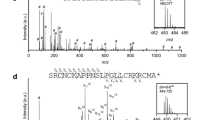Abstract
Several neurotoxins have been isolated from bee venom1. One of these, the mast cell degranulating peptide (MCD), releases histamine from mast cells and on central administration produces arousal at low concentrations and convulsions at higher doses2,3. These effects are mediated through specific high-affinity binding sites4 which are concentrated in cortical structures, notably the hippocampus3. This structure appears to be the source of changes in the electrocorticogram that follow injections of MCD into the cerebral ventricle, and which induce a quasi-permanent hippocampal theta rhythm in the motionless rat alternating with epileptiform spike waves3. We report here that brief application of MCD to the CA1 region of hippocampal slices induces long-term potenti-ation, that is, a long-lasting increase in the efficacy of synaptic transmission. This potentiation seems to be indistinguishable from the classical LTP produced by trains of high-frequency electrical stimulation5,6 and considered to be related in some way to memory. Using binding to synaptosomal membranes and radioimmunoassay techniques, we have also found an endogenous peptide equivalent of MCD in brain extracts. This raises the possibility that a MCD-like peptide may be important in long-term potentiation.
This is a preview of subscription content, access via your institution
Access options
Subscribe to this journal
Receive 51 print issues and online access
$199.00 per year
only $3.90 per issue
Buy this article
- Purchase on Springer Link
- Instant access to full article PDF
Prices may be subject to local taxes which are calculated during checkout
Similar content being viewed by others
References
1. Habermann, E. Science 177, 314–322 (1972). 2. Habermann, E. Naunyn–Schmiedebergs Archs Pharmak. 300, 189–191 (1977). 3. Bidard, J. N., Gondolfo, G., Mourre, C., Gottesman, C. & Lazdunski, M. Brain Res. (in the press). 4. Taylor, J. W., Bidard, J. N. & Lazdunski, M. J. biol Chem. 259, 13957–13967 (1984). 5. Bliss, T. V. P. & Lomo, T. /. Physiol., Lond. 232, 331–356 (1973). 6. Andersen, P., Sundberg, S. H., Sveen, O., Swann, J. W. & Wigstrom, H. /. Physiol., Lond. 302, 463–482 (1980). 7. Gho, M., King, A. E., Ben Ari, Y. & Cherubini, E. Brain Res. 385, 411–414 (1986). 8. Wigstrom, H. & Gustafsson, B. Nature 301, 603–604 (1983). 9. Miles, R. & Wong, R. K. S., J. Physiol., Lond. 373, 397–418 (1986). 10. Wigstrom, H., Gustafsson, B. & Huang, Y. Y. Neuroscience 17, 1105–1115 (1986). 11. Baraban, J. M., Snyder, S. H. & Alger, B. E. Proc. natn. Acad. Sci. U.S.A. 82,2538–2542 (1985). 12. Malenka, R. C., Madison, D. V., Andrade, R. & Nicoll, R. A. J. Neurosci. 6,475–480 (1986). 13. Kandel, E. R. & Schwartz, J. H. Science 218, 433–443 (1982). 14. De Riemer, S. A., Strong, J. A., Albert, K. A., Greengard, P. & Kaczmarek, L. K. Nature 313,313–316(1985). 15. Nelson, R. B. & Routtenberg, A. Expl Neurol. 89, 213–224 (1985). 16. Malenka, R. C., Madison, D. V. & Nicoll, R. A. Nature 321, 175–177 (1986). 17. Hugues, M., Romey, G., Duval, D., Vincent, J. P. & Lazdunski, M. Proc. natn. Acad. Sci. U.S.A. 79, 1308–1312 (1982). 18. Lazdunski, M. Cell Calcium 4, 421–428 (1984). 19. Fosset, M., Schmid–Antomarchi, A., Hugues, M., Romey, G. & Lazdunski, M. Proc. natn. Acad. Sci. U.S.A. 81, 7228–7232 (1984). 20. Schwartzkroin, P. A. & Prince, D. A. Brain Res. 147, 117–130 (1978). 21. Schweitz, H. & Lazdunski, M. Toxicon 22, 985–988 (1984).
Author information
Authors and Affiliations
Rights and permissions
About this article
Cite this article
Cherubini, E., Ari, Y., Gho, M. et al. Long-term potentiation of synaptic transmission in the hippocampus induced by a bee venom peptide. Nature 328, 70–73 (1987). https://doi.org/10.1038/328070a0
Received:
Accepted:
Issue Date:
DOI: https://doi.org/10.1038/328070a0
This article is cited by
-
Ecological mechanisms and prospects for utilization of toxins from parasitic hymenopterans
Frontiers of Forestry in China (2008)
-
Novel form of long-term potentiation produced by a K+channel blocker in the hippocampus
Nature (1991)
-
Pharmacology of long-term potentiation
Pharmaceutisch Weekblad Scientific Edition (1991)
Comments
By submitting a comment you agree to abide by our Terms and Community Guidelines. If you find something abusive or that does not comply with our terms or guidelines please flag it as inappropriate.



